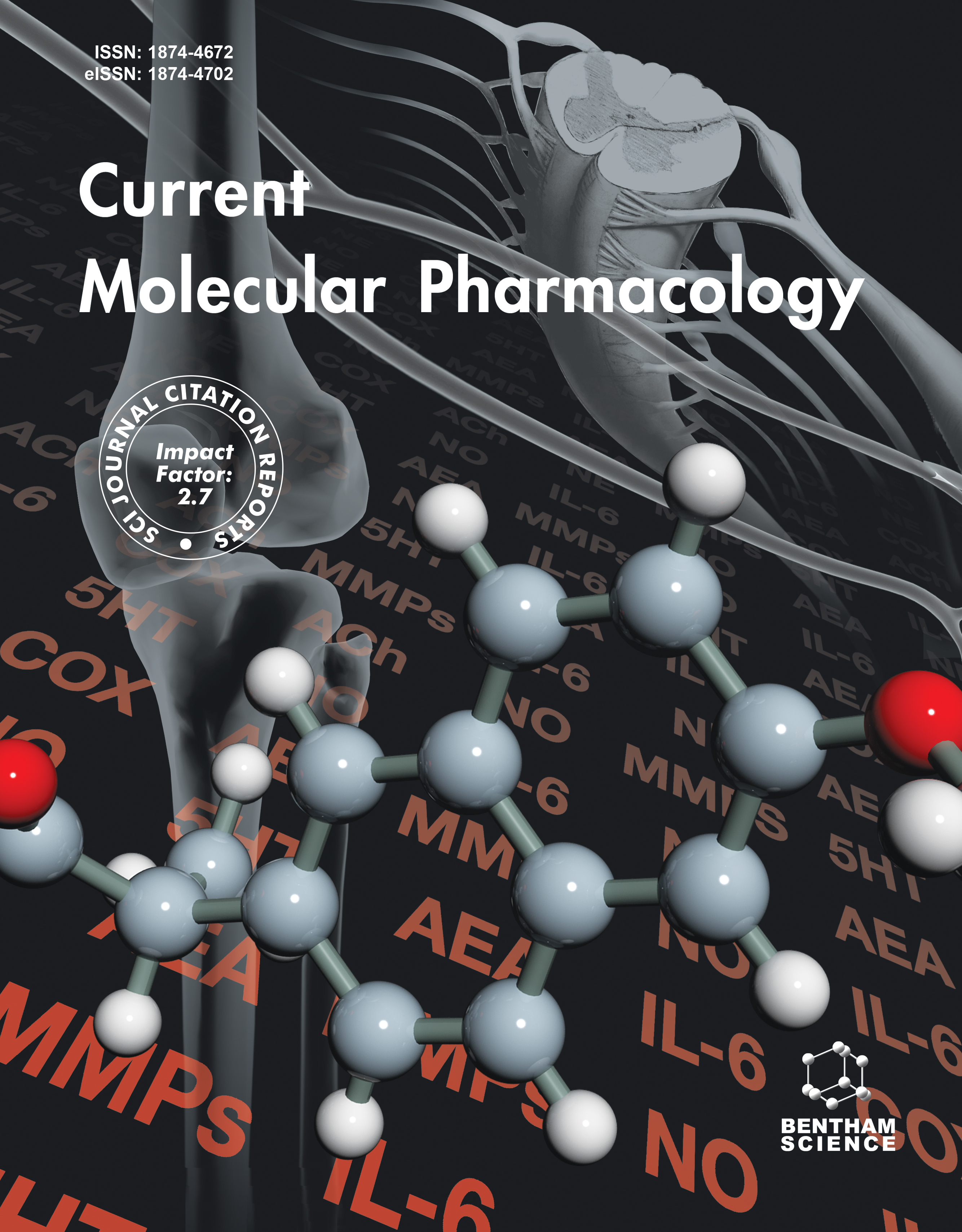- Home
- A-Z Publications
- Current Molecular Pharmacology
- Previous Issues
- Volume 15, Issue 7, 2022
Current Molecular Pharmacology - Volume 15, Issue 7, 2022
Volume 15, Issue 7, 2022
-
-
Drug Repurposing for Cancer Therapy in the Era of Precision Medicine
More LessAuthors: Kenneth K.W. To and William C.S. ChoDrug repurposing refers to the identification of clinically approved drugs with the known safety profiles and defined pharmacokinetic properties for new indications. Despite the advances in oncology research, cancers are still associated with the most unmet medical needs. Drug repurposing has emerged as a useful approach for the search for effective and durable cancer treatment. It may also represent a promising strategy to Read More
-
-
-
Moving Towards Dawn: KRas Signaling and Treatment in Pancreatic Ductal Adenocarcinoma
More LessAuthors: Tarun Rajpurohit and Sankha Bhattacharya“Pancreatic ductal adenocarcinoma (PDAC)” is robust, nearly clueless, and all-around deadly among all tumors. Below 10 %, the general 5-year endurance period has remained adamantly unaltered in the last 30 years, regardless of enormous clinical and therapeutic endeavors. The yearly number of deaths is more than the number of recently analyzed cases. Not a classic one, but “Carbohydrate Antigen CA19- 9” remains t Read More
-
-
-
Potential Therapeutic Strategies to Combat HCC
More LessAuthors: Sidra Altaf, Faiza Saleem, Azam A. Sher and Ashiq AliHepatocellular carcinoma (HCC) is a complex, life-threatening and most common neoplasm in the world. HCC tumors are genetically and phenotypically heterogeneous, and involve various molecular mechanisms and stimulation of several signaling pathways, such as Vascular Endothelial Growth Factor, Epidermal Growth Factor Receptors (EGFR), Insulin growth factor, Ras/extracellular signal-stimulated kinase, t Read More
-
-
-
Agomelatine: An Astounding Sui-generis Antidepressant?
More LessAuthors: Muhammad Naveed, Lian-Di Li, Gang Sheng, Zi-Wei Du, Ya-Ping Zhou, Sun Nan, Ming-Yi Zhu, Jing Zhang and Qi-Gang ZhouMajor depressive disorder (MDD) is one of the foremost causes of disability and premature death worldwide. Although the available antidepressants are effective and well tolerated, they also have many limitations. Therapeutic advances in developing a new drug's ultimate relation between MDD and chronobiology, which targets the circadian rhythm, led to a renewed focus on psychiatric disorders. In order to provide a critical an Read More
-
-
-
Quercetin and Glioma: Which Signaling Pathways are Involved?
More LessGliomas are the most common brain tumors. These tumors commonly exhibit continuous growth without invading surrounding brain tissues. Dominant remedial approaches suffer limited therapy and survival rates. Although some progress has been made in conventional glioma treatments, these breakthroughs have not yet proven sufficient for treating this malignancy. The remedial options are limited given glio Read More
-
-
-
Fangchinoline Inhibited Proliferation of Neoplastic B-lymphoid Cells and Alleviated Sjögren’s Syndrome-like Responses in NOD/Ltj Mice via the Akt/mTOR Pathway
More LessAuthors: Yanxiong Shao, Jiayao Fu, Tianle Zhan, Lei Ye and Chuangqi YuBackground: Fangchinoline is a bisbenzylisoquinoline alkaloid extracted from Stephania tetrandra S. Moore that is conventionally used as an analgesic, antirheumatic, and antihypertensive drug in China. However, the application of Fanchinoline in Sjögren syndrome (SS) remains unreported. Objective: This study aimed to identify the potential role of Fangchinoline in the treatment of SS via altering Akt/mTOR signa Read More
-
-
-
Gamma-Tocotrienol Synergistically Promotes the Anti-proliferative and Pro-apoptotic Effects of Etoposide on Breast Cancer Cell Lines
More LessAuthors: Maya Idriss, Maria Younes, Sonia Abou Najem, Mohammad H. Hodroj, Rajaa Fakhoury and Sandra RizkBackground: Breast Cancer is one of the most commonly diagnosed cancers worldwide and a major cause of death among women. Although chemotherapeutic agents remain the keystones in cancer therapy, significant side effects have failed to provide a safe and tolerable treatment for cancer patients. Dietary antioxidant vitamins were extensively investigated over the past years and their relevance in cancer chemother Read More
-
-
-
Evaluation of the Effect of Isobutyl Paraben and 2-ethyl Hexyl Paraben on P-glycoprotein Functional Expression in Rats: A Pharmacokinetic Study
More LessAuthors: Osama Y. Alshogran, Nour F. Al Ghraiybah and Sayer I. Al-AzzamBackground: Pharmaceutical excipients have been shown to influence drug disposition through modulating transport protein. Objectives: This study assessed the effect of single dose administration of parabens on the pharmacokinetics (PK) of digoxin, a probe substrate of p-glycoprotein (p-gp), in vivo. Also, the effect of multiple dosing of parabens on p-gp expression was examined. Methods: Rats were randomized into four groups Read More
-
-
-
Humanin Ameliorates Late-onset Hypogonadism in Aged Male Rats
More LessAuthors: Hany A. El Kattawy, Eman R. Abozaid and Doaa M. AbdullahBackground: The potential to reproduce declines with age. Late-onset hypogonadism is characterized by reduced serum testosterone. Humanin is a mitochondrial-derived signaling peptide encoded by short open reading frames within the mitochondrial genome. It may protect against some age-related diseases such as atherosclerosis by its cytoprotective effects. Objective: The study aimed to investigate the potential anti-aging Read More
-
-
-
Cryptotanshinone Induces Necroptosis Through Ca2+ Release and ROS Production in vitro and in vivo
More LessAuthors: Wentong Zhao, Yuanbo Song, Qin-Qin Wang, Shan Han, Xin-Xing Li, Yushun Cui, Hongwei Gao, Renyikun Yuan and Shilin YangBackground: Necroptosis is a type of programmed necrosis mediated by receptor-interacting protein kinases 1 and 3 (RIP1 and RIP3), which is morphologically characterized by enlarged organelles, ruptured plasma membrane, and subsequent loss of intracellular contents. Cryptotanshinone (CPT), a diterpene quinone compound extracted from the root of Salvia miltiorrhiza Bunge, has been reported to have Read More
-
-
-
Promising Anticancer Activity of Multitarget Cyclin Dependent Kinase Inhibitors against Human Colorectal Carcinoma Cells
More LessAuthors: Sonal M. Manohar and Kalpana S. JoshiBackground: Colorectal cancer (CRC) is the third leading cause of cancer death worldwide, and its incidence is steadily rising in developing nations. Cell cycle aberrations due to deregulation of cyclin dependent kinases (CDKs) and cyclins are common events during colorectal carcinogenesis. Yet, efficacy of multitarget CDK inhibitors as therapeutic agents has not been much explored against CRC. Objective: The anticancer potentia Read More
-
Most Read This Month
Article
content/journals/cmp
Journal
10
5
false
en


